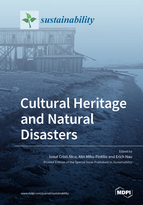Cultural Heritage and Natural Disasters
A special issue of Sustainability (ISSN 2071-1050). This special issue belongs to the section "Tourism, Culture, and Heritage".
Deadline for manuscript submissions: closed (15 December 2020) | Viewed by 25733
Special Issue Editors
Interests: natural hazards; spatial analysis; risk assessment; GIS; soil erosion; cultural heritage
Interests: natural hazards; hydrology; geographic information system; remote sensing; environment
Special Issues, Collections and Topics in MDPI journals
Special Issue Information
Dear Colleagues,
Over the last decade, the intensity of natural disasters has increased all over the world, and they are being studied accordingly with the use of the newest GIS technologies and remote sensing. This means that they affect more and more cultural heritage sites in different parts of the world. This Special Issue focuses on the theory and the practice of applying modern technologies and methodology to advance the knowledge on cultural heritage of “living” together with natural disasters. Throughout history, natural disasters have destroyed significant cultural heritage sites (e.g., the mausoleum of Halicarnassus, which was destroyed by floods and earthquakes). The importance and value of cultural heritage is a significant legacy for future generations, and therefore, studies, policies, and management measures are needed.
Authors are invited to submit papers on the application of remote sensing and/or GIS in domains such as natural disasters (which could include but is not limited to landslides, gully erosion, floods, earthquakes, and coastal erosion), (long-term) monitoring and surveying, spatiotemporal analysis or predictive modeling (as a tool of analyzing the vulnerability of cultural heritage towards a specific or more natural disasters), and sustainable ways for cultural heritage safeguarding and conservation. The integration of modern technologies will provide a relevant contribution in our endeavor for safeguarding cultural heritage.
We welcome contributions where the aforementioned tools are combined and/or stand alone in relevant case studies. Theoretical and practical studies that bring a significant contribution in the field of natural disasters and cultural heritage are preferred. These are a set of interest topics for this Special Issue, in order to cover a larger spectrum of subjects and to ensure significant contributions:
- Integration of remote sensing and GIS for cultural heritage assessment;
- New tools and methods to generate new data and to continue possible monitoring process(es);
- Novel 3D technologies used in the monitoring of cultural heritage (e.g., TLS);
- Geophysical prospection for cultural heritage assessment and mitigation;
- UAV data for monitoring and mapping of geohazards;
- Climate change impacts on cultural heritage;
- New methods to quantify the vulnerability of cultural heritage towards natural disasters;
- Sustainable methods and tools for cultural heritage assessment and conservation.
Novel and stimulating techniques in studying the above points, along with their applications and relevant case studies, will be considered. Thorough review papers are also welcome.
Dr. Ionut Cristi Nicu
Dr. Alin Mihu-Pintilie
Mr. Erich Nau
Guest Editors
Manuscript Submission Information
Manuscripts should be submitted online at www.mdpi.com by registering and logging in to this website. Once you are registered, click here to go to the submission form. Manuscripts can be submitted until the deadline. All submissions that pass pre-check are peer-reviewed. Accepted papers will be published continuously in the journal (as soon as accepted) and will be listed together on the special issue website. Research articles, review articles as well as short communications are invited. For planned papers, a title and short abstract (about 100 words) can be sent to the Editorial Office for announcement on this website.
Submitted manuscripts should not have been published previously, nor be under consideration for publication elsewhere (except conference proceedings papers). All manuscripts are thoroughly refereed through a single-blind peer-review process. A guide for authors and other relevant information for submission of manuscripts is available on the Instructions for Authors page. Sustainability is an international peer-reviewed open access semimonthly journal published by MDPI.
Please visit the Instructions for Authors page before submitting a manuscript. The Article Processing Charge (APC) for publication in this open access journal is 2400 CHF (Swiss Francs). Submitted papers should be well formatted and use good English. Authors may use MDPI's English editing service prior to publication or during author revisions.








